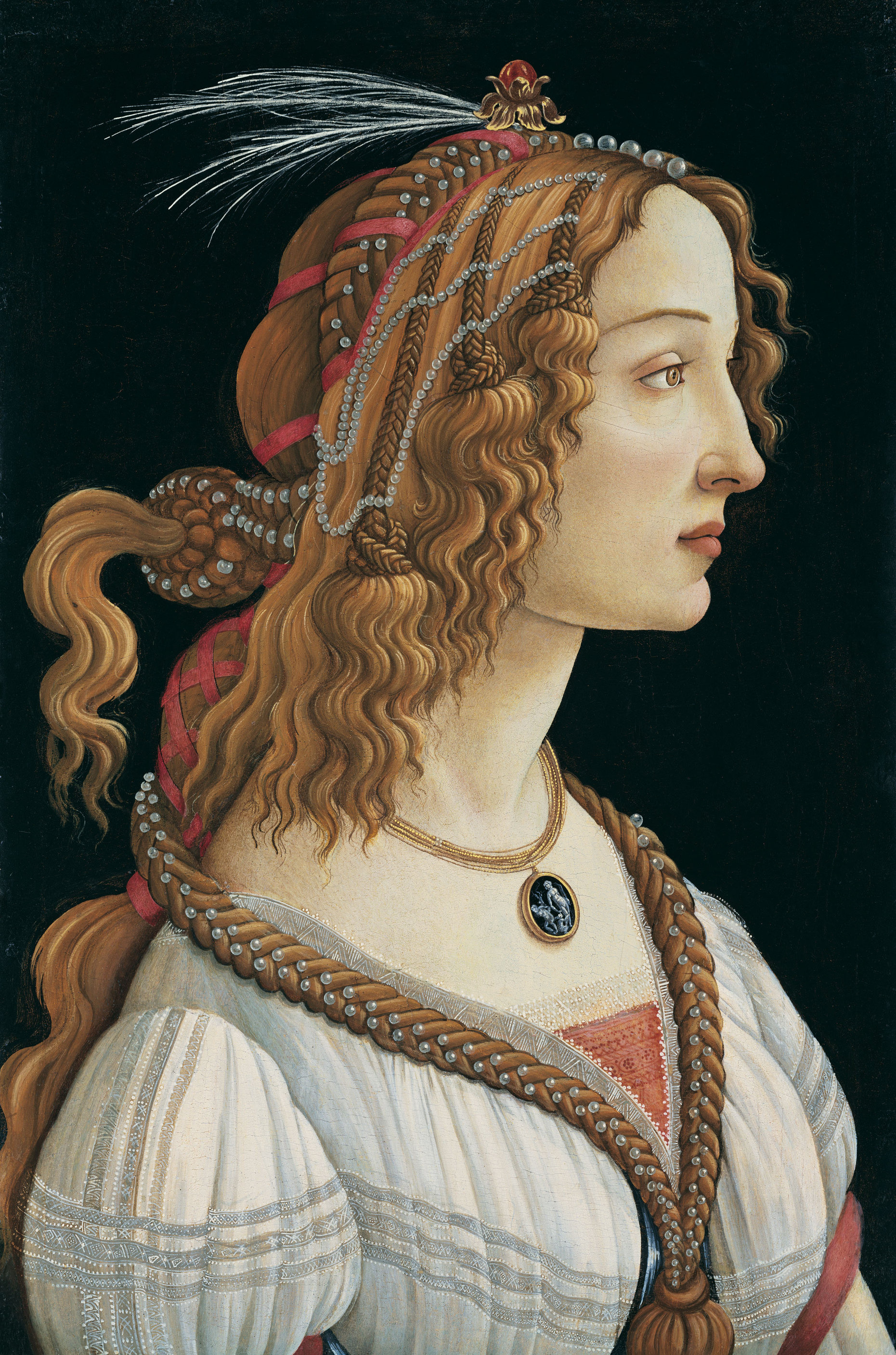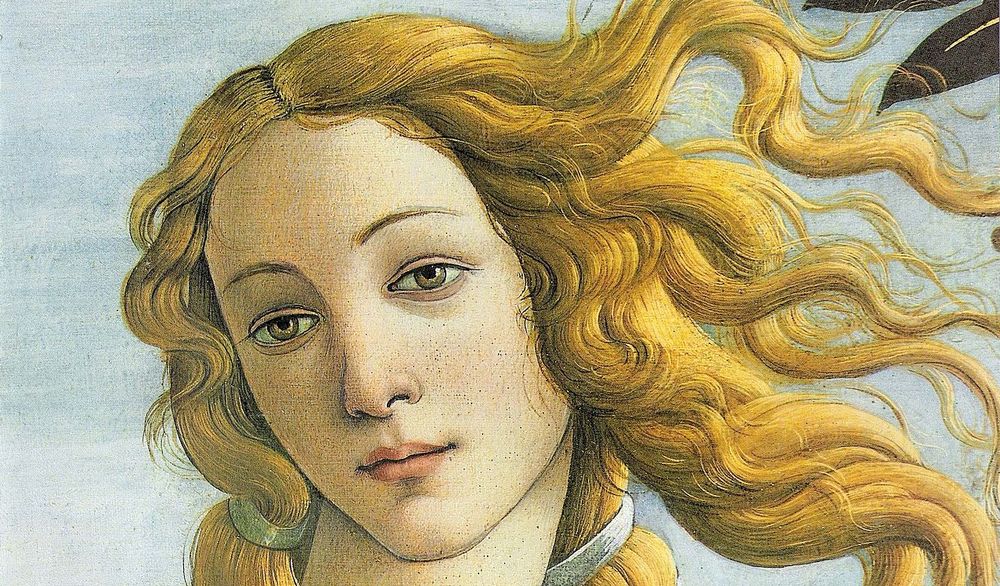
Sandro Botticelli (or Botticelli’s school) – Idealized portrait of a lady (portrait of Simonetta Vespucci as nymph), ca. 1475 – Städel Museum Frankfurt
The young woman of this portrait attributed to Sandro Botticelli, with wires perle braided hair, a cameo in the neck depicting Apollo, Marsyas and Olympus, and a ruby on the head with even pearls, is nowadays celebrated everywhere as the icon of beauty of the Renaissance. The cameo of the portrait (known also as Sigillo di Nerone) was one of the most highly prized gems (about 1000 fiorins) of Lorenzo de’ Medici’s collection (see Melissa Meriam Bullard and Nicolai Rubinstein, “Lorenzo de’ Medici’s Acquisition of the Sigillo di Nerone”, Journal of the Warburg and Courtauld Institutes Vol. 62, 1999, pp. 283-286).
Simonetta Vespucci (nee Cattaneo) was born in Fezzano di Portovenere (La Spezia) or Genova on January 28 (?) 1453 from Gaspare Cattaneo and Caterina (Cattocchia) Violante Spinola di Obizzo (the widow of Battista Campofregoso, doge of Genova for a day in 1437, before her second marriage). Details of her life are mostly unknown, but her story has reached us mainly thanks to the paintings of Botticelli.
We have some clues that Simonetta was loved by Giuliano de’ Medici, brother of Lorenzo il Magnifico, but there is no proof of a real relationship. Indeed some sonnets composed by Giuliano de’ Medici on the death of a lady could be related to her, and according to a manuscript from the Biblioteca Nazionale Centrale di Firenze, Simonetta was “oggetto continuo e palese delle sue amorose poesie” (continuous and evident target of his loving poems). In April 1469 she married the youth Marco Vespucci, cousin of Amerigo Vespucci, with a combined marriage that took place perhaps in Piombino, where Marco’s father Piero Vespucci used to be hosted by the Appiani family for his business. The Florence’s catasto of 1469-1470 registers the presence of Marco and Simonetta: “Marco di Piero di Giuliano Vespucci anni XVI; Simonetta di messer Guasparri Catani sua donna di anni XVI“. They were both 16 years old.

Domenico Ghirlandaio – Deposizione (Pietà) – Cappella Vespucci – Church of Ognissanti – Florence – ca. 1472. Some authors identify Simonetta with the third woman from the right in the upper part of the fresco (but could be Lisabetta Mini, wife of Nastagio Vespucci), Amerigo could be the first man from the left in the lower part (but could be Amerigo’s grandfather, himself called Amerigo).
The Cattaneo family evidently had interest in strengthen their links with the Vespucci, a powerful family of florentine bankers. Simonetta and Marco settled in Florence, and Lorenzo il Magnifico invited the couple for a rich party in the family’s palazzo at via Larga, and then for another one in the Villa Medicea at Careggi.
Simonetta was celebrated not only in paintings (she is identified, among others, with the woman in Botticelli’s The Birth of Venus and in a portrait of Piero di Cosimo) but also in literature.
Luigi Pulci (a childhood friend of Lorenzo de’ Medici), his brother Bernardo (in the elegy De obitu divae Simonettae and in the sonnet La diva Simonetta a Julian de’ Medici), the poet Girolamo Benivieni, the veronese poet Francesco Nursio Timideo, and an anonymous poet dedicated to Simonetta some poems in vernacular; Lorenzo himself celebrated her iconic beauty with four sonnets in his Comento de’ miei sonetti (in the sonnet O chiara stella che co’ raggi tuoi he imagined that Simonetta came up to the sky to enrich the firmament), while Michele Marullo, the florentine humanist Naldo Naldi, the pistoian poet and cleric Tommaso Baldinotti, Piero di Francesco Dovizi da Bibbiena (later Lorenzo’s private secretary and tutor of his son, he wrote the elegy Heulogium in Simonettam puellam formosissimam morientem), Alessandro Cortesi (a Poliziano’s friend), and Poliziano himself composed works on Simonetta in latin. Poliziano wrote in the unfinished poem Stanze Cominciate per la Giostra del Magnifico Giuliano di Piero de’ Medici that during a knightly joust that took place in Piazza Santa Croce on January 29 1475, Giuliano de’ Medici won the competition taking with him a portrait of Simonetta. The little portrait, that had been painted by Botticelli, had a french inscription saying La sans par (the unparalleled one).
Simonetta was described later in 1515 by Tommaso Sardi, a dominican monk of the convent of Santa Maria Novella, in his commentary De Anima Peregrina. A series of latin elegies composed about in 1475 by the rimanese poet Giovanni Aurelio Augurelli (Amica ad magnanimum Iulianum Medicem), in which an amica (friend) celebrates Giuliano’s victory, could refer to Simonetta.
In the last days of Simonetta’s illness Lorenzo il Magnifico was in Pisa; he sent his doctor (maestro Stefano) to assist her. Stefano said that the patient illness was not tuberculosis, but maestro Moisè (Vespucci’s doctor) disagree. They disputed about the administration of a medicine to the patient, and they finally gave it, but nothing could be done, and she died, probably of tuberculosis or pneumonia, according to the symptoms described by Piero Vespucci in the letters to Lorenzo de’ Medici (fever, vomit, breathless of chest, insomnia, lack of appetite) on friday April 26 1476. She was 23.
Lorenzo’s agent Sforza Bettini sent a letter to Lorenzo to announce her death with these words: “La benedetta anima della Simonetta se ne andò a Paradiso, come so harette inteso: puossi ben dire che sia stato il secondo Trionpho della morte, che veramente havendola voi vista così morta come la era, non vi saria parsa manco bella e vezzosa che si fusse in vita: requiescat in pace” (Simonetta’s blessed soul came to Paradise, as you know; you can well say that it has been the second Triumph of death, truly because if you’d have seen her dead as she was you’d have recognized she was not less beautiful and pretty than she was when alive: may she rest in peace).

Letter of Sforza Bettini (27 April 1476) to Lorenzo de’ Medici announcing the death of Simonetta Vespucci – Archivio di Stato di Firenze, Mediceo Avanti Principato, filza 33, c. 318
According to Lorenzo de’ Medici’s account of the funeral (though it could be not completely reliable), Simonetta was carried to her resting place uncovered (white dressed, according to Bernardo Pulci), to let anyone admiring her beauty, and surrounded by a crowd of people.
She was buried in the Church of Ognissanti, though the exact location of the burial site is unknown. It has been said that Botticelli loved and idealized her beauty so much that he asked to be buried at her feet.

